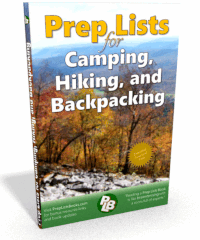A section in Chapter 2 of the book:
Prep Lists for Camping, Hiking, and Backpacking
Liquid Chlorine Bleach
Unscented household bleach is one of the best, easiest, cheapest, and most readily available products for water treatment. It kills bacteria, parasites, and viruses, and most any living microorganism in water before breaking down and going away. However, it is less effective with protozoa, so use caution if that might be in your area.
- Use 8 to 16 drops of bleach (or about ¼ teaspoon) to disinfect one gallon of water (double for muddy or cloudy water). Mix well and let sit for half an hour. Immediately after treating, water should have a slight smell of chlorine—if it does not, apply more bleach, mix well, and wait another ten minutes.
- Remember that bleach is very powerful. One teaspoon can treat a five-gallon bucket, so don’t overdo it.
- Bleach that is more than a year old loses about half of its potency, so adjust the dosage accordingly.
- After water has been treated with bleach, the smell of chlorine will go away in a day or two—much like with city water.
- Water in large tanks can be treated regularly about once or twice a month to keep it free of contaminants. Remember that bleach does not stay chemically active for more than a few days and that most germs need sunlight to grow.
- A one-ounce vial of bleach, kept in a backpack or survival kit, can treat over 100 gallons of water.
- If water is relatively clear and has a chlorine smell, it is disinfected, harmless, and fully drinkable.
Caution: Treating water with bleach does NOT remove things like
chlorine, gasoline, ammonia, herbicides, pesticides, arsenic, lead, mercury, etc.
Use a charcoal filter to help remove these.
Dry Chlorine Powder
Also known as calcium hypochlorite, this is used mostly for swimming pools. As a powder, it has an extended shelf life, and may be stored up to 10 years with minimal degradation.
IMPORTANT: After treating water with dry chlorine powder,
let the water stand for 24 hours before drinking.
- For chlorinating water in large tanks, use ¼ ounce by weight per 250 gallons.
- For chlorinating a 55-gallon drum of water, use 1/20 ounce (one level teaspoon).
- A 5-gallon bucket needs 1/200 ounce (a tiny pinch)
- A one-quart canteen needs 1/4000 ounce (just a few individual grains of the powder).
- A small, one-ounce vial of chlorine powder, kept in a backpack or survival kit, can treat 4000 canteens of water.
Iodine
Most iodine bottles include instructions for use. If yours doesn’t, use 10 to 12 drops for one gallon of water. Increase the dosage if the water is cloudy or of questionable quality. Mix well and let stand for half an hour before using. Iodine does leave an unpleasant aftertaste.
Other Treatments
Follow instructions carefully for these alternative treatments, and remember to consider the shelf life for potency.
- Water Purification Tablets—usually either chlorine or iodine
- Iodine Crystals—a concentrated form of iodine
- Stabilized Oxygen—new products on the market include Aerobic 07, Aerox, Aquagen, Dynamo 2, and Genesis 1000.
- Desalination—removing salt from sea water (see Distilling Water section)
>>> This information is in the book “Prep Lists for Camping, Hiking, and Backpacking.” <<<


You must log in to post a comment. Log in now.